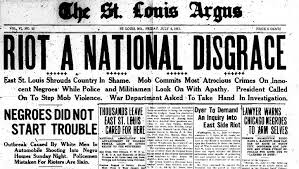Recall Vicious Race Riot,
After Black Soldiers Marched in Houston.
Many Died. Pershing Opposes Integration.
Special to The Great War Project.
(7 January) Thousands of black Americans hoped service in the army would soon lead to equality more broadly in the United States, but they were disappointed.
Blacks agitated for more equality, but unfortunately, they were pressing their demands in an atmosphere of racial tension, and violence.
The American commander, General John J. Pershing, would permit black regiments already in France to integrate with French regiments, but not with white units.

Black American troops arrive in Europe.
Here’s the background…
Tensions reached their peak in the spring, a century ago in East St. Louis, Illinois, where according to historian Margret Wagner, “angry whites randomly attacked blacks on the streets, the first of several violent episodes that continued through the spring.”
“Then on July 2nd a century ago, months of tension exploded in a full-scale riot. White gangs encouraged by mobs of cheering spectators rampaged through parts of the city, beating and killing blacks and burning hundreds of their homes and businesses.”
Reported historian Wagner, “People were being shot down and thrown back into fire if they tried to escape,” one survivor wrote. “It was later estimated that forty black people were killed and hundreds injured.” Nine whites also died, some killed by friendly fire.
News of the riot and violence shocked the nation. Declared the dean of Howard University, “the German press will report these incidents with ghoulish glee. The principle of democracy is on trial before the world today as it has never been before. A democracy that will not stand the acid test of race and color is no democracy at all.”
The riot in East S. Louis was the largest and ugliest of several racial atrocities and ironically it occurred in the wake of a triumph for African Americans hoping that full participation in the war would aid their quest for equality.
That spring the War Department opens “the long sought training camp for black officers, with many college graduates,” and hundreds of non-commissioned officers from the ranks of black regiments.
The training camp was located outside Houston, Texas, and keenly aware of the events in East St. Louis, the trainers sought to keep the trainees busy and away from the city of Houston.
But that was not entirely possible. Jim Crow regulations prevailed in Houston, and many blacks had no interest in obeying.
Writes historian Wagner, “after city police pistol-whipped two soldiers on various pretexts. About a hundred enraged infantrymen marched into the city, shooting indiscriminately, rousing white civilians into a frenzy of confused resistance until the black soldiers’ anger dissipated.”
It came to be known as the Houston Mutiny.
Seventeen whites were killed, according to Wagner. Two of the mutineers.
News of the mutiny reached the President. After that, the entire battalion was disarmed and redeployed to New Mexico.
“Official retribution thereafter was swift, uncompromising, and alarming to African Americans. In the year after the mutiny, the army court-martialed 118 soldiers, found 110 guilty, hanged 19 without opportunity for appeal, and imprisoned 63 for life.”
No white soldier was ever tried for harassing or beating black soldiers.
Some Senators demanded that all black soldiers be removed from their states.
Secretary of War Baker suspended induction of black soldiers, and delayed commissioning for months more than six hundred black officers.

Black American unit training for France.
General Pershing, the American army’s commander, made excuses,” writes historian Gary Mead, “about the segregation practiced in the army he commanded. “The truth is that neither he nor his general staff wanted black regiments serving in combat roles in the American Expeditionary Force alongside white soldiers.”

The St. Louis Riot occurred in 1917 as did the Houston Riot. Unfortunately your excellent article makes it Sound as if the riots happened in the Spring of 1918.